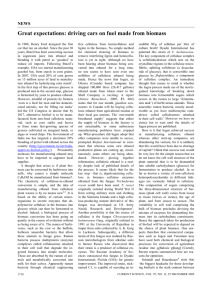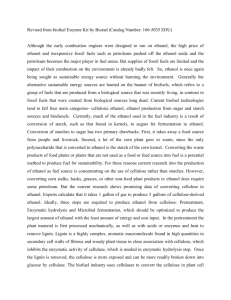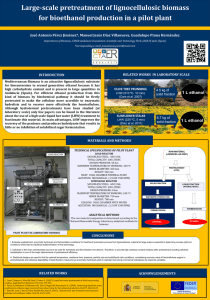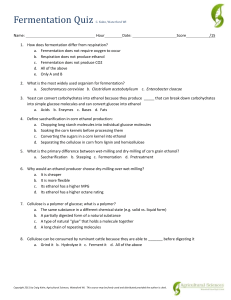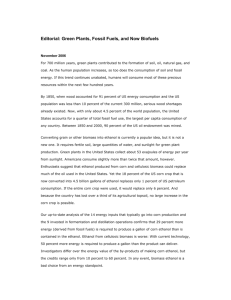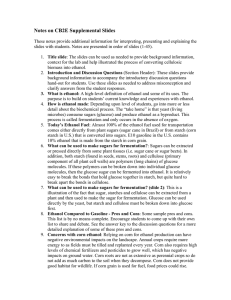Converting Cellulosic Biomass to Ethanol
advertisement
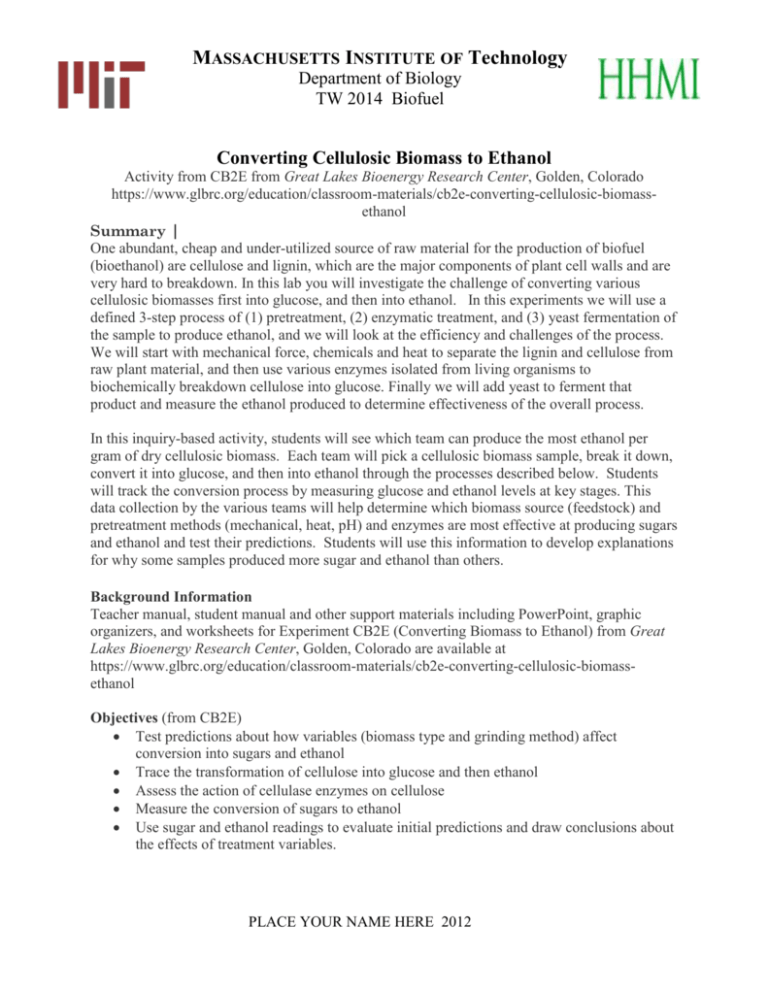
MASSACHUSETTS INSTITUTE OF Technology Department of Biology TW 2014 Biofuel Converting Cellulosic Biomass to Ethanol Activity from CB2E from Great Lakes Bioenergy Research Center, Golden, Colorado https://www.glbrc.org/education/classroom-materials/cb2e-converting-cellulosic-biomassethanol Summary | One abundant, cheap and under-utilized source of raw material for the production of biofuel (bioethanol) are cellulose and lignin, which are the major components of plant cell walls and are very hard to breakdown. In this lab you will investigate the challenge of converting various cellulosic biomasses first into glucose, and then into ethanol. In this experiments we will use a defined 3-step process of (1) pretreatment, (2) enzymatic treatment, and (3) yeast fermentation of the sample to produce ethanol, and we will look at the efficiency and challenges of the process. We will start with mechanical force, chemicals and heat to separate the lignin and cellulose from raw plant material, and then use various enzymes isolated from living organisms to biochemically breakdown cellulose into glucose. Finally we will add yeast to ferment that product and measure the ethanol produced to determine effectiveness of the overall process. In this inquiry-based activity, students will see which team can produce the most ethanol per gram of dry cellulosic biomass. Each team will pick a cellulosic biomass sample, break it down, convert it into glucose, and then into ethanol through the processes described below. Students will track the conversion process by measuring glucose and ethanol levels at key stages. This data collection by the various teams will help determine which biomass source (feedstock) and pretreatment methods (mechanical, heat, pH) and enzymes are most effective at producing sugars and ethanol and test their predictions. Students will use this information to develop explanations for why some samples produced more sugar and ethanol than others. Background Information Teacher manual, student manual and other support materials including PowerPoint, graphic organizers, and worksheets for Experiment CB2E (Converting Biomass to Ethanol) from Great Lakes Bioenergy Research Center, Golden, Colorado are available at https://www.glbrc.org/education/classroom-materials/cb2e-converting-cellulosic-biomassethanol Objectives (from CB2E) Test predictions about how variables (biomass type and grinding method) affect conversion into sugars and ethanol Trace the transformation of cellulose into glucose and then ethanol Assess the action of cellulase enzymes on cellulose Measure the conversion of sugars to ethanol Use sugar and ethanol readings to evaluate initial predictions and draw conclusions about the effects of treatment variables. PLACE YOUR NAME HERE 2012 MASSACHUSETTS INSTITUTE OF Technology Department of Biology TW 2014 Biofuel Materials in the Kit designed for class of 24, working in groups of 3 and available upon request to Mandada@mit.edu) will include: 6 Vernier LabQuest LabQ2 @ 329.00 8 Vernier Ethanol Sensors ETH_BTA @ #109.00 1 roll Plumbers tape 4 TRUEbalance Blood Glucose Meters (1 other Blood Glucose Meter) Blood Glucose Strips for TRUEbalance or other meter (specific to meter) 100 strips/class Parafilm Disposable pipettes (30 for 1 class) Celluclast (Cellulase) in aqueous solution o For cellulase (C2730) the optimal pH range is 4.5 - 6.0, and the optimal temperature range is 50 - 60°C. o Produced by submerged fermentation of a selected strain of the fungus Trichoderma reesei and catalyzes the breakdown of cellulose into glucose, cellobiose, and higher glucose polymers. 50mL falcon tubes, 2 packages of 20 Printed copy of student manual Printed copy of teacher manual Materials provided by the school Weigh boats Electronic Balance Grinder for biomass samples Scissors, shears, saw for cutting biomass 25 or 50 ml graduates 600 ml beakers Hot plates Thermometer Blender to cut up Biomass Samples, such as Ninja Kitchen System Pulse (BL201) Grinder or similar product Other enzymes if desired (pectinase, amylase) Procedure Student and Teacher Manuals for CB2E available at https://www.glbrc.org/education/classroom-materials/cb2e-converting-cellulosic-biomassethanol and single copies are included in the kit. PLACE YOUR NAME HERE 2012 MASSACHUSETTS INSTITUTE OF Technology Department of Biology TW 2014 Biofuel Additional Resources at https://www.glbrc.org/education/classroom-materials/cb2e-converting-cellulosic-biomassethanol Concept Map 8.5x14.pdf Concept Map.pdf Developing a Scientific Argument.pdf Introduction Discussion Questions.pdf Introduction Questions Answer Key.pdf Presentation slides Slide notes.pdf Why is it so difficult to make cellulosic ethanol? pdf PLACE YOUR NAME HERE 2012 MASSACHUSETTS INSTITUTE OF Technology Department of Biology TW 2014 Biofuel PLACE YOUR NAME HERE 2012 MASSACHUSETTS INSTITUTE OF Technology Department of Biology TW 2014 Biofuel PLACE YOUR NAME HERE 2012

